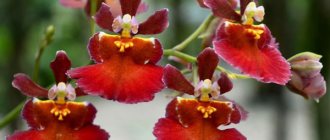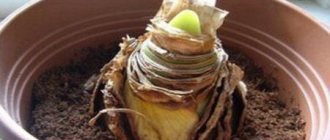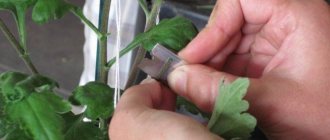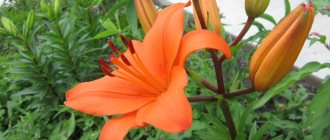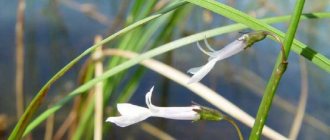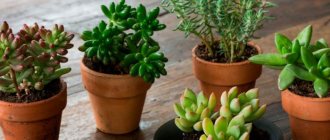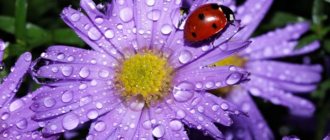Plants » Flowers
0
2036
Article rating
Kira Stoletova
Orchid babies are small shoots that appear on peduncles, at the root collar or on stems. They grow for 5-6 months, producing leaves and roots. They are then separated from the mother plant and replanted. In this way, a new plant is obtained that retains its varietal qualities.
Orchid babies
What is it and what does it look like: description and photo
Orchid babies are small shoots on peduncles at the root collar or stem. Within six months they grow and develop, putting out leaves. As soon as the shoot becomes large, it is carefully disconnected from the mother tree and transplanted into a separate pot.
The photo shows what baby orchids look like:
Priming
For orchids, it is important to use special soil, which is sold in the store. You can do it yourself. To do this you will need crushed tree bark and a peat mixture. Tree bark soil can retain moisture longer. You can lay a layer of sphagnum moss on top. Thanks to the use of moss, it is possible to protect the roots of the plant from burning during watering with hard water and applying fertilizers.
Soil for plants
What can you do to achieve the high level of humidity that a young orchid needs? At first it should be covered with polyethylene or a plastic bottle on top.
It is recommended to water the transplanted plant for the first time only after 2-3 days. During this time, the cut will have time to tighten. The moss should be sprayed daily with water, to which you can add Kornevin. It is a root formation stimulator. The plant can then be watered as the soil dries.
For the successful development of a small orchid, it must be kept in greenhouse conditions for about a year. Then it can be replanted and cared for like an adult plant. It is possible to get an attractive plant that will have beautiful unique flowers only after a couple of years.
Secrets of successful maintenance and propagation of tropical plants
How does it appear on the stem?
It is very easy to distinguish a new plant from an old one. The future orchid is formed from irregularities located on the stem - dormant buds.
If a flower has sprouted a shoot on the trunk, then first thin white shoots (sticks) begin to extend from the base. They increase in size over time. The buds gradually swell, from which leaves will appear in the future. The roots are the last to form.
In the first 10 days, it is difficult to determine what will develop from the swollen bud. It is important to pay attention to the tip: if it is slightly pointed, then a flower will grow, if it is blunt, then a baby will grow.
Conditions of appearance
In order for babies to form on the arrow of the orchid, after the plant has finished blooming, it is necessary not to cut off the peduncle completely (read about what to do with the arrow when the orchid has already bloomed). It should simply be shortened, the cut point is 2 cm above the “sleeping” bud. In addition, the plant must be provided with a sufficient amount of intense light, which awakens the bud from sleep, and a high temperature regime.
Reference. If after flowering the arrow is left untouched, the orchid can “dry” it completely in order to save nutrients.
Find out in this material whether you should worry if the peduncle of an orchid has dried up and what to do in such a situation.
The cut must be made with a disinfected pruner. This must be done with great care, as the trunk and leaves of the plant can easily be damaged. In addition, if any hangnails or roughness remain, this can lead to the orchid becoming infected with infectious diseases. It is recommended to treat the cut area with cinnamon or crushed activated carbon.
A visual video on how to stimulate the appearance of a baby on a peduncle after the orchid has bloomed:
How long does it take to “mature” before separation?
The young plant must be next to the “mother” for at least 6 months. However, in each case individual conditions should be taken into account:
- climate;
- growth rate;
- variety.
There are a number of main signs by which you can determine that the time has come for a child to start living independently:
- the roots of the branch are five cm deep and have at least three roots;
- five to six leaves have formed on the plant;
- the baby should be a rich green color (without rot and dry parts).
If you are not completely sure that it is time to plant the orchid offspring, it is better to wait. According to experts, the baby can develop on the main flower within 12 months.
Purpose of appearance
The main purpose of the appearance of a baby is reproductive; the plant thus produces offspring and tries to prolong life. Propagation of orchids by children appearing on the arrow is one of the most popular methods of propagating certain types of orchids at home among gardeners.
Before raising a baby, you need to know what to do when an orchid has released a peduncle, and also how to force an orchid to produce several peduncles if it is stubborn and does not produce even one.
Why might a flower not sprout?
Some plant species do not reproduce by children. Sometimes new shoots do not develop due to improper care and growing conditions of the “mother” flower. There are a number of rules that experts advise to follow:
- the orchid should not touch cold windows;
- It is better to place a flowerpot with a flower in a warm place where there are no drafts;
- the optimal temperature for growth and development is + 20-28 degrees Celsius;
- air humidity should be about 85%;
- In winter, it is advisable to create additional lighting (at least 13 hours a day).
In the summer, jars of water can be placed around the orchid, and in the cold season, the radiators should be covered with damp towels to maintain the desired indoor climate.
Root extension
Under favorable conditions, young rosettes usually manage to grow good roots on their own, receiving nutrition from the mother plant. But sometimes children do not release roots for a long time, or they release them, but they are too small. Then root growth must be stimulated artificially using the following methods:
- While the baby is not separated from the mother orchid, its base is wrapped in damp moss and carefully secured with thread. The moss needs to be moistened regularly, and the area should be wrapped in cling film to retain moisture. To speed up the growth of roots, the plant is provided with bright light for at least 12 hours.
- For a separated baby, you can create a small greenhouse from a small jar or cup with a lid with holes made in it. Drainage is laid out at the bottom of a transparent container, and crushed pine bark treated with boiling water is placed on top. The baby is planted in this greenhouse. With daily moistening and ventilation, roots quickly appear.
- You can also make a hole in a piece of polystyrene foam, attach the baby to it, and place it in a container with water. The base of the socket must not touch the water. To increase humidity, the leaves can sometimes be sprayed.
Step-by-step care instructions
If you decide to start breeding orchids, you need to study the factors influencing the formation of children, as well as the rules for caring for future plants.
If the process is missing
Shoots do not always grow on their own. Sometimes they need to be properly stimulated for the flower to begin to reproduce. There are several proven methods that even novice gardeners can use:
- cut off the peduncle at a distance of 2 cm from the bud;
- place the pot on the balcony or windowsill (spring-summer period);
- choose a warm place for the plant;
- applying cytokinin paste to the kidney (you must first make a small scratch or remove dried scales);
- fertilizing with nitrogen every two weeks.
How to care for it as it grows?
In order for a small plant to develop successfully, it is important to monitor the maintenance of comfortable living conditions for it:
- water an adult orchid when the ground becomes dry;
- wipe the leaves from the underside at least three times a week;
- fertilize after flowering ends;
- Avoid using dry fertilizers.
It is necessary to apply fertilizing 30-40 minutes after watering. For the first time, it is better to take half the dose, and then gradually increase it.
How to take it?
As soon as the small plant has formed, it must be separated from the “mother” flower and replanted. It is important to make sure that the roots of the baby are large enough and will be able to feed on their own.
If there is no doubt about this, you should take a sharp knife and cut off the shoot. It is best to treat damaged areas with crushed activated carbon, which will prevent infection.
The baby needs to be placed in an aqueous solution of potassium permanganate. A small orchid is planted in a pot with drainage. There is no need to compact the soil. It is advisable to cover the roots with a special substrate.
You cannot cut off all the shoots at once if the plant has several of them. Numerous damages can lead to the death of the flower. Children should be removed as the wounds from previous cuts heal.
From the video you will learn how to properly plant a baby orchid on a peduncle:
How to grow roots?
Roots are the pride of an orchid and an indicator of its viability. To activate their growth, you can use several types of solutions:
- Kornevin;
- Heteroauxin;
- honey with water;
- honey with aloe juice.
Experts advise using sphagnum moss to stimulate the root system after transplantation. To achieve the desired effect, it is important to follow the correct sequence of actions:
- soak the moss for 30 minutes, let it swell;
- install a support, fix the plant;
- spread moss on top of the substrate;
- cover with film (don’t forget to ventilate);
- Spray with water every day;
- use fertilizer once a week.
The first watering after transplantation is carried out no earlier than 4-5 days later.
How to speed up the growth of the roots of a baby orchid on a peduncle, learn from this video:
Transplanting a plant into a separate substrate
Transplanting a new plant into a separate substrate is quite simple, but you still need to know some details. First you should prepare for this procedure. To do this, the separated cuttings (described above on how to properly trim the baby) need to be soaked in water for at least 15 minutes. If desired, you can add a growth enhancer to the water (any one is suitable, but you need to dilute it correctly - following the instructions). Why is soaking necessary? Wet roots are more flexible and less susceptible to being placed in a pot.
Now take a container for the plant. You need to lay a drainage layer on its bottom. You can use vermiculite, expanded clay or ceramic shards. Choose the option that is convenient for you. Next, the plant is lowered into the pot and held so that the leaves are higher than the top point of the pot. The substrate is carefully poured so as not to injure the roots. In this case, you need to lightly tap on the sides of the pot so that the soil is evenly laid. But do not pack the soil mixture too tightly, as aerial roots need access to carbon dioxide for nutrition. Leave the plant in this form for two to three days, after which you can water the plant.
Advice! First, the baby separated from the mother specimen must be placed in partial shade. After a few days you can install it in diffused light. But make sure that the baby is not exposed to direct sunlight, which will lead to burns.
What can be used to speed up the formation of the root system in a baby orchid? A good choice would be one of the following drugs, which can be purchased at a specialty store:
- "Ribav-Extra". The manufacturer positions the composition as a root former. It is used to treat flowers, as an anti-stress agent and to accelerate the formation of roots in young plants, ensuring their better survival. The composition is diluted on the basis that two drops of the product are needed per liter of water.
- "Zircon". This drug is universal. That is why, when diluting it, you need to make a weaker solution than indicated in the instructions, so as not to harm the orchid. For a child, it is enough to add four drops of the product to one liter of warm, settled water. The drug itself belongs to the group of phytohormones, so it can be considered one of the best feeding options. The basis of the product is an extract of Echinacea purpurea.
- "Radifarm". The drug is developed on the basis of various plant extracts. It is able to actively stimulate the growth of the root system, ensure better survival rate and guarantee the survival of plants. For an orchid, it is important to dilute the composition correctly: add one drop of the product to a liter of water.
- "Etamon." The product has positively proven itself as a stimulator of root system formation. The main advantage of the product is the presence of phosphorus and nitrogen in the composition, which are necessary for the orchid. Correct dilution of the composition requires that you add one ampoule of the product to a liter of water.
As you can see, separating a baby from an adult orchid is a simple procedure. To ensure everything works out exactly, you need to follow the recommendations given. This is a guarantee that the plant will take root and no problems will arise. Remember that you cannot separate the baby while the orchid is blooming. Wait until the flowers fall and the plant enters the resting phase. Pruning small plants from the mother specimen during the flowering period is stressful for the plant, which can lead to a deterioration in its health: lethargy, falling leaves, and stunted growth.
